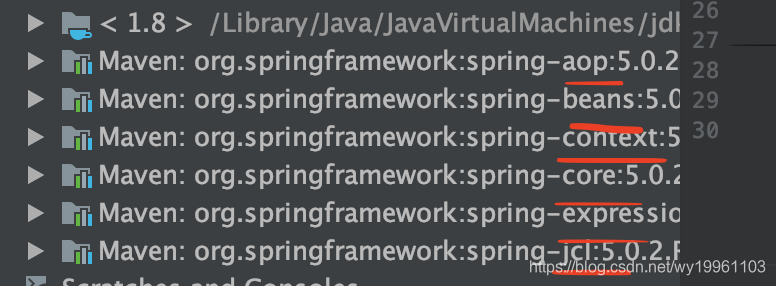一、入门案例
前提注意:
spring5 版本是用 jdk8 编写的,所以要求我们的 jdk 版本是 8 及以上。
同时 tomcat 的版本要求 8.5 及以上。
1.导入jar包
<packaging>jar</packaging>
<dependencies>
<dependency>
<groupId>org.springframework</groupId>
<artifactId>spring-context</artifactId>
<version>5.0.2.RELEASE</version>
</dependency>
</dependencies>
4个核心(beans、core、context、expression) + 1个依赖(commons-loggins…jar)

2.配置文件(bean.xml)
让 spring 管理资源,在配置文件中配置 service 和 dao
<?xml version="1.0" encoding="UTF-8"?>
<beans xmlns="http://www.springframework.org/schema/beans"
xmlns:xsi="http://www.w3.org/2001/XMLSchema-instance"
xsi:schemaLocation="http://www.springframework.org/schema/beans
http://www.springframework.org/schema/beans/spring-beans.xsd">
<bean id="accountService" class="com.itheima.service.impl.AccountServiceImpl"> </bean>
<bean id="accountDao" class="com.itheima.dao.impl.AccountDaoImpl"> </bean>
</beans>
<!--把对象的创建交给spring管理-->
3.测试是否成功
/**
* 模拟一个表现层,用于调用业务层
*/
public class Client {
/*获取spring的核心容器,并根据id获取对象
*/
public static void main(String[] args) {
//1.获取核心容器对象
ApplicationContext ac =new ClassPathXmlApplicationContext("bean.xml");
//2.根据id获取bean对象
IAccountService as = (IAccountService) ac.getBean("accountService");
IAccountDao adao = ac.getBean("accountDao",IAccountDao.class);
System.out.println(as);
System.out.println(adao);
}
}
运行结果

二、相关知识
spring 中工厂的类结构图

ApplicationContext的三个实现类:
ClassPathXmlApplicationContext:
它是从类的根路径下加载配置文件 推荐使用这种
FileSystemXmlApplicationContext:
它是从磁盘路径上加载配置文件,配置文件可以在磁盘的任意位置。
AnnotationConfigApplicationContext:
当我们使用注解配置容器对象时,需要使用此类来创建 spring 容器。它用来读取注解。
BeanFactory 才是 Spring 容器中的顶层接口。
ApplicationContext 是它的子接口。
BeanFactory (多例)和 ApplicationContext(单例) 的区别:
创建对象的`时间点`不一样。
ApplicationContext:构建核心容器时,只要一读取配置文件,默认情况下就会创建对象。 可以debug状态跟踪
BeanFactory:延迟加载的方式,什么时候会根据ID获取对象,什么使用什么时候创建对象。
三、 spring中bean的细节之三种创建Bean对象的方式


<?xml version="1.0" encoding="UTF-8"?>
<beans xmlns="http://www.springframework.org/schema/beans"
xmlns:xsi="http://www.w3.org/2001/XMLSchema-instance"
xsi:schemaLocation="http://www.springframework.org/schema/beans
http://www.springframework.org/schema/beans/spring-beans.xsd">
<!--把对象的创建交给spring来管理-->
<!--spring对bean的管理细节
1.创建bean的三种方式
2.bean对象的作用范围
3.bean对象的生命周期
-->
<!--创建Bean的三种方式 -->
<!-- 第一种方式:使用默认构造函数创建。
在spring的配置文件中使用bean标签,配以id和class属性之后,且没有其他属性和标签时。
采用的就是默认构造函数创建bean对象,此时如果类中没有默认构造函数,则对象无法创建。-->
<bean id="accountService" class="com.itheima.service.impl.AccountServiceImpl"></bean>
第二种方式: 使用普通工厂中的方法创建对象(使用某个类中的方法创建对象,并存入spring容器)
<bean id="instanceFactory" class="com.itheima.factory.InstanceFactory"></bean>
<bean id="accountService" factory-bean="instanceFactory" factory-method="getAccountService">
</bean>
<!-- 第三种方式:使用工厂中的静态方法创建对象(使用某个类中的静态方法创建对象,并存入spring容器)
<bean id="accountService" class="com.itheima.factory.StaticFactory" factory-method="getAccountService"></bean>
-->
</beans>
四、Bean的作用范围
Bean的作用范围调整
Bean标签的scope属性:
作用:用于指定Bean的作用范围
取值:singleton 单例的
prototype 多例的
request 作用于web应用的请求范围
session 作用于web应用的会话范围
global——session 作用于集群环境的会话范围(全局会话范围),当不是集群环境时,它就是session
<bean id="accountService" class="com.itheima.service.impl.AccountServiceImpl" scope="singleton"></bean>
简单理解global session

五.bean的生命周期
Bean对象的生命周期:单例与双例
单例:
出生:当容器创建时,对象出生
活着:容器存在,对象活着
死亡:容器销毁,对象死亡
总结:单例对象的生命周期和容器相同
bean.xml
<bean id="accountService" class="com.itheima.service.impl.AccountServiceImpl"
scope="singleton" init-method="init" destroy-method="destory"></bean>
public class AccountServiceImpl implements IAccountService {
public AccountServiceImpl(){
System.out.println("对象创建了");
}
public void saveAccount() {
System.out.println("service中的account方法执行了");;
}
public void init() {
System.out.println("对象初始化了");;
}
public void destory() {
System.out.println("对象销毁了");;
}
}
public static void main(String[] args) {
//1.获取核心容器对象
ClassPathXmlApplicationContext ac = new ClassPathXmlApplicationContext("bean.xml");
//2.根据id获取Bean对象
IAccountService as = (IAccountService)ac.getBean("accountService");
as.saveAccount();
// ((ClassPathXmlApplicationContext) ac).close();
ac.close();
}

六、spring的依赖注入
依赖注入(Dependency Injection)
IOC的作用:降低程序间的耦合(依赖关系)
依赖关系的管理:以后都交给spring来维护
在当前类需要用到其他类对象,由spring为我们提供我们只需要在配置文件中说明
依赖关系的维护:就称之为依赖注入
能注入的数据有三类
基本类型和String
其他bean类型(在配置文件中或者注解配置过的Bean)
复杂类型/集合类型
注入的方式有三种:
第一种:使用构造函数提供
第二种:使用set方法t提供
第三种:使用注解提供
方式一:构造函数注入
使用的标签:`constructor-org`
标签出现的位置:`bean标签的内部`
标签中的属性
type:用于指定要注入的数据的数据类型,该数据类型也是构造函数中某个或某些参数的类型
index:用于指定要注入的数据给构造函数中指定索引位置的参数赋值。索引的位置是从0开始
name:用于指定给构造函数中指定名称的参数赋值 常用的
=======以上三个用于指定给构造函数中哪个参数赋值=
value:用于提供基本类型和String类型的数据
ref:用于指定其他的bean类型数据。它指的就是在spring的Ioc核心容器中出现过的bean对象
优势:在获取bean对象时,注入数据是必须的操作,否则对象无法创建成功。
弊端:改变了bean对象的实例化方式,使我们在创建对象时,如果用不到这些数据,也必须提供。

<bean id="accountService" class="com.itheima.service.impl.AccountServiceImpl">
<constructor-arg name="name" value="test"> </constructor-arg>
<constructor-arg name="age" value="18"></constructor-arg>
<constructor-arg name="birthday" ref="now"></constructor-arg>
</bean>
<!--配置一个日期对象-->
<bean id="now" class="java.util.Date"></bean>
结果

方式二:使用set方法提供
set方法注入 —— 更常用的方式
涉及的标签:property
出现的位置:bean标签的内部
标签的属性
name:用于指定注入时所调用的set方法名称
value:用于提供基本类型和String类型的数据
ref:用于指定其他的bean类型数据。它指的就是在spring的Ioc核心容器中出现过的bean对象
优势:创建对象时没有明确的限制,可以直接使用默认构造函数
弊端:如果有某个成员必须有值,则获取对象是有可能set方法没有执行。
<bean id="accountService2" class="com.itheima.service.impl.AccountServiceImpl2">
<property name="name" value="Test"></property>
<property name="age" value="21"></property>
<property name="birthday" ref="now"></property>
</bean>


方式三:使用注解提供(注入集合数据)
1.添加集合set方法

2.在Bean.xml添加注入
<bean id="accountService3" class="com.itheima.service.impl.AccountServiceImpl3">
<property name="myStrs">
<array>
<value>AAA</value>
<value>BBB</value>
<value>CC</value>
</array>
</property>
<property name="myLists">
<list>
<value>AAA</value>
<value>BBB</value>
<value>CC</value>
</list>
</property>
<property name="myset">
<set>
<value>A</value>
<value>B</value>
<value>C</value>
</set>
</property>
<property name="myMap">
<map>
<entry key="testA" value="AAA"></entry>
<entry key="testB" value="BBB"></entry>
</map>
</property>
<property name="myProps">
<props>
<prop key="testa">aaa</prop>
<prop key="testb">bbb</prop>
</props>
</property>
</bean>
注意:
复杂类型的注入/集合类型的注入
用于给List结构集合注入的标签:
list array set
用于个Map结构集合注入的标签:
map props
结构相同,标签可以互换

